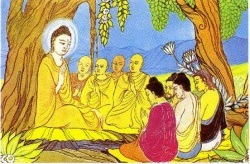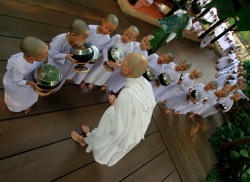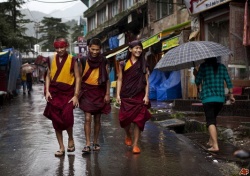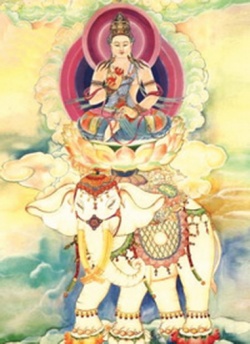Difference between revisions of "Buddha-Nature According to Gelug-Chittamatra, Svatantrika, and Prasangika"
(Created page with " <poem> Tsenzhab Serkong Rinpoche II translated by Alexander Berzin {{Wiki|Graz}}, {{Wiki|Austria}}, October, 2002, revised May 2006 Introduction The Tibetan te...") |
|||
| Line 1: | Line 1: | ||
| − | + | {{DisplayImages|3235|2834|574|867|1120}} | |
<poem> | <poem> | ||
[[Tsenzhab Serkong Rinpoche]] II | [[Tsenzhab Serkong Rinpoche]] II | ||
| Line 7: | Line 7: | ||
Introduction | Introduction | ||
| − | The [[Tibetan]] term [[rigs]], meaning “[[caste]]” or “family,” appears in the technical term sangs-rgyas-kyi | + | The [[Tibetan]] term [[rigs]], meaning “[[caste]]” or “family,” appears in the technical term [[sangs-rgyas-kyi rigs]] ([[Buddha-caste]], [[Buddha-family]]) and is usually translated as “ [[Buddha-nature]].” More specifically, in the context of the [[discussion]] of [[Buddha-nature]], it means a caste-trait or family-trait. |
There are two types of family-traits: | There are two types of family-traits: | ||
| − | naturally abiding family-traits ([[rang-bzhin | + | naturally abiding family-traits ([[rang-bzhin gnas-rigs]]), |
| − | evolving family-traits (rgyas-‘gyur-gyi | + | evolving family-traits ([[rgyas-‘gyur-gyi rigs]]). |
The [[discussion]] of [[Buddha-nature]] appears only among the [[Mahayana]] schools of [[Indian]] {{Wiki|tenets}}, namely [[Chittamatra]], [[Svatantrika-Madhyamaka]], and [[Prasangika-Madhyamaka]]. Each of these schools of {{Wiki|tenets}} interprets [[Buddha-nature]] differently. Here, we shall survey some of the basic differences, according to the [[Gelug]] presentation. | The [[discussion]] of [[Buddha-nature]] appears only among the [[Mahayana]] schools of [[Indian]] {{Wiki|tenets}}, namely [[Chittamatra]], [[Svatantrika-Madhyamaka]], and [[Prasangika-Madhyamaka]]. Each of these schools of {{Wiki|tenets}} interprets [[Buddha-nature]] differently. Here, we shall survey some of the basic differences, according to the [[Gelug]] presentation. | ||
| Line 28: | Line 28: | ||
According to [[Chittamatra]], the naturally abiding family-traits are the [[seeds]] (sa-bon) that, without beginning, are imputable on the basis of the stained [[mind]] of each limited being ([[sentient being]]) and which serve as factors allowing that being to attain one of three [[purified states]] ([[byang-chub]], Skt. [[bodhi]]). The [[purified states]] are those of an [[arhat]] ({{Wiki|liberated}} being) – either a [[shravaka]] [[arhat]] or [[pratyekabuddha]] [[arhat]] – or that of an [[enlightened being]] ([[bodhisattva]] [[arhat]], [[Buddha]]). | According to [[Chittamatra]], the naturally abiding family-traits are the [[seeds]] (sa-bon) that, without beginning, are imputable on the basis of the stained [[mind]] of each limited being ([[sentient being]]) and which serve as factors allowing that being to attain one of three [[purified states]] ([[byang-chub]], Skt. [[bodhi]]). The [[purified states]] are those of an [[arhat]] ({{Wiki|liberated}} being) – either a [[shravaka]] [[arhat]] or [[pratyekabuddha]] [[arhat]] – or that of an [[enlightened being]] ([[bodhisattva]] [[arhat]], [[Buddha]]). | ||
| − | The evolving family-traits are the [[seeds]] that, newly gained by listening to, contemplating, or [[meditating]] on [[Buddha’s teachings]], are imputable on the basis of the stained [[mind]] of each limited being and which serve as factors allowing that being to attain [[arya]] pathway [[minds]] (‘ phags-lam) in the category of [[shravakas]], [[pratyekabuddhas]], or [[bodhisattvas]]. The [[arya]] pathways of [[mind]] are [[seeing]] pathway [[minds]] ([[path of seeing]]), accustoming pathway [[minds]] ([[path of meditation]]), and pathway [[minds]] needing no further training ([[paths]] of no more training). | + | The evolving family-traits are the [[seeds]] that, newly gained by listening to, contemplating, or [[meditating]] on [[Buddha’s teachings]], are imputable on the basis of the stained [[mind]] of each limited being and which serve as factors allowing that being to attain [[arya]] pathway [[minds]] (‘ [[phags-lam]]) in the category of [[shravakas]], [[pratyekabuddhas]], or [[bodhisattvas]]. The [[arya]] pathways of [[mind]] are [[seeing]] pathway [[minds]] ([[path of seeing]]), accustoming pathway [[minds]] ([[path of meditation]]), and pathway [[minds]] needing no further training ([[paths]] of no more training). |
| + | |||
One or Three {{Wiki|Ultimate}} Vehicles of [[Mind]] | One or Three {{Wiki|Ultimate}} Vehicles of [[Mind]] | ||
| − | Within the [[Chittamatra]] school, the Followers of | + | Within the [[Chittamatra]] school, the [[Followers of Scripture]] ([[lung-gi rjes-‘brang-gi sems-tsam-pa]]) and the [[Followers of Logic]] ([[rigs-pa’i rjes-‘brang-gi sems-tsam-pa]]) both accept the above assertions, but differ concerning further details. |
| − | [[Chittamatra]] Followers of | + | [[Chittamatra]] [[Followers of Scripture]] assert, in addition to [[limited beings]] of the [[shravaka]], [[pratyekabuddha]], or [[bodhisattva]] families, there are persons of uncertain family and persons of no family. |
Persons of uncertain family are those [[limited beings]] who have naturally abiding family-traits, but which are not specifically in the [[shravaka]], [[pratyekabuddha]], or [[bodhisattva]] categories. | Persons of uncertain family are those [[limited beings]] who have naturally abiding family-traits, but which are not specifically in the [[shravaka]], [[pratyekabuddha]], or [[bodhisattva]] categories. | ||
| Line 39: | Line 40: | ||
Persons of no family are those [[limited beings]] whose naturally abiding family-traits have been severed, either temporarily or forever. No {{Wiki|matter}} how many evolving traits they may build up after they have severed their [[roots]] of positive force (dge-ba’i [[rtsa-ba]]) ({{Wiki|equivalent}} to the naturally-abiding family traits), they can never develop [[renunciation]] and reach [[liberation]]. | Persons of no family are those [[limited beings]] whose naturally abiding family-traits have been severed, either temporarily or forever. No {{Wiki|matter}} how many evolving traits they may build up after they have severed their [[roots]] of positive force (dge-ba’i [[rtsa-ba]]) ({{Wiki|equivalent}} to the naturally-abiding family traits), they can never develop [[renunciation]] and reach [[liberation]]. | ||
| − | The Followers of | + | The [[Followers of Scripture assert]] that among [[shravaka]] and [[pratyekabuddha]] [[arhats]] who have achieved [[nirvana with residue]] ([[lhag-bcas-kyi mya-ngan-‘das]]), some may enter the [[bodhisattva path]] and some may chose not to enter it. Once these [[arhats]] have passed away from the [[lifetime]] in which they have achieved [[arhatship]] – in other words, once they have achieved [[nirvana without residue]] ([[lhag-bcas-kyi mya-ngan-‘das]]), they are no longer able to enter the [[bodhisattva path]]. Thus, [[Chittamatra]] [[Followers of Scripture assert]] three [[Wikipedia:Absolute (philosophy)|ultimate]] vehicles of [[mind]] ([[mthar-thug theg-pa]], [[Wikipedia:Absolute (philosophy)|ultimate]] vehicles) – [[shravaka-yana]], [[pratyekabuddha-yana]], and [[bodhisattva-yana]]. In other words, they assert three [[Wikipedia:Absolute (philosophy)|ultimate]] goals that can be achieved and then last forever – [[shravaka]] [[arhatship]], [[pratyekabuddha]] [[arhatship]], and [[Buddhahood]]. |
| + | |||
| + | The [[Chittamatra]] [[Followers of Logic]] do not accept that anyone’s [[roots]] of positive force can be severed completely. Thus, they do not assert that there are [[limited beings]] of no family. Moreover, they assert only one [[Wikipedia:Absolute (philosophy)|ultimate]] [[vehicle]] of [[mind]]. Thus, all [[shravaka]] and [[pratyekabuddha]] [[arhats]], even after achieving [[nirvana without residue]], will eventually develop [[bodhichitta]] and enter the [[bodhisattva path]]. The only goal that will last forever is that of [[Buddhahood]]. | ||
| − | |||
[[Svatantrika-Madhyamaka]] | [[Svatantrika-Madhyamaka]] | ||
According to [[Svatantrika-Madhyamaka]], the naturally abiding family-traits are the [[voidnesses]] ([[chos-nyid]], the actual [[nature]]) imputable on the basis of the stained [[mind]] of each limited being. | According to [[Svatantrika-Madhyamaka]], the naturally abiding family-traits are the [[voidnesses]] ([[chos-nyid]], the actual [[nature]]) imputable on the basis of the stained [[mind]] of each limited being. | ||
| − | The evolving family-traits are the factors, imputable on the basis of the stained [[mind]] of each limited being, that are fit to become the [[essential | + | The evolving family-traits are the factors, imputable on the basis of the stained [[mind]] of each limited being, that are fit to become the [[essential nature]] ([[ngo-bo ‘gyur-rung]]) of a [[deep awareness]] [[Dharmakaya]] ([[ye-shes chos-sku]]). |
| − | A whole depends on its parts and a [[universal]] or collective depends on the {{Wiki|individual}} items included in it. A stained [[mind]], as a collective or whole, depends on [[grasping]] for [[true existence]] (bden-‘dzin) as one of its constituent {{Wiki|individual}} items or parts. Nevertheless, [[grasping]] for [[true existence]] is not fit to become the [[essential]] [[nature]] of a | + | A whole depends on its parts and a [[universal]] or collective depends on the {{Wiki|individual}} items included in it. A stained [[mind]], as a collective or whole, depends on [[grasping]] for [[true existence]] ([[bden-‘dzin]]) as one of its constituent {{Wiki|individual}} items or parts. Nevertheless, [[grasping]] for [[true existence]] is not fit to become the [[essential]] [[nature]] of a [[deep awareness]] [[Dharmakaya]]. Only the [[enlightenment]]-building network of [[deep awareness]] ([[ye-shes-kyi tshogs]], [[collection of wisdom]]), built up by total [[absorption]] on [[voidness]], free from [[grasping]] for [[true existence]], is an evolving family-trait. |
| − | Thus, an actual enlightenment-building network of deep [[awareness]] is imputable on the basis of a stained [[mind]] as a whole – once the [[mental]] {{Wiki|continuum}} of that [[mind]] has [[attained]] a [[Mahayana path]] of building up ([[path of accumulation]]). However, it cannot be [[imputed]] on the basis of the [[grasping]] for [[true existence]] included in the {{Wiki|continuum}} of that stained [[mind]]. | + | Thus, an actual [[enlightenment]]-building network of deep [[awareness]] is imputable on the basis of a stained [[mind]] as a whole – once the [[mental]] {{Wiki|continuum}} of that [[mind]] has [[attained]] a [[Mahayana path]] of building up ([[path of accumulation]]). However, it cannot be [[imputed]] on the basis of the [[grasping]] for [[true existence]] included in the {{Wiki|continuum}} of that stained [[mind]]. |
[See: The Two Enlightenment-Building Networks (The [[Two Collections]] ).] | [See: The Two Enlightenment-Building Networks (The [[Two Collections]] ).] | ||
Revision as of 15:38, 3 August 2014
Tsenzhab Serkong Rinpoche II
translated by Alexander Berzin
Graz, Austria, October, 2002, revised May 2006
Introduction
The Tibetan term rigs, meaning “caste” or “family,” appears in the technical term sangs-rgyas-kyi rigs (Buddha-caste, Buddha-family) and is usually translated as “ Buddha-nature.” More specifically, in the context of the discussion of Buddha-nature, it means a caste-trait or family-trait.
There are two types of family-traits:
naturally abiding family-traits (rang-bzhin gnas-rigs),
evolving family-traits (rgyas-‘gyur-gyi rigs).
The discussion of Buddha-nature appears only among the Mahayana schools of Indian tenets, namely Chittamatra, Svatantrika-Madhyamaka, and Prasangika-Madhyamaka. Each of these schools of tenets interprets Buddha-nature differently. Here, we shall survey some of the basic differences, according to the Gelug presentation.
Chittamatra
In general, the Chittamatra school of tenets speaks of three major castes or families:
the shravaka family of listeners to Buddha’s teachings,
the pratyekabuddha family of self-evolvers,
the bodhisattva family.
According to Chittamatra, the naturally abiding family-traits are the seeds (sa-bon) that, without beginning, are imputable on the basis of the stained mind of each limited being (sentient being) and which serve as factors allowing that being to attain one of three purified states (byang-chub, Skt. bodhi). The purified states are those of an arhat (liberated being) – either a shravaka arhat or pratyekabuddha arhat – or that of an enlightened being (bodhisattva arhat, Buddha).
The evolving family-traits are the seeds that, newly gained by listening to, contemplating, or meditating on Buddha’s teachings, are imputable on the basis of the stained mind of each limited being and which serve as factors allowing that being to attain arya pathway minds (‘ phags-lam) in the category of shravakas, pratyekabuddhas, or bodhisattvas. The arya pathways of mind are seeing pathway minds (path of seeing), accustoming pathway minds (path of meditation), and pathway minds needing no further training (paths of no more training).
One or Three Ultimate Vehicles of Mind
Within the Chittamatra school, the Followers of Scripture (lung-gi rjes-‘brang-gi sems-tsam-pa) and the Followers of Logic (rigs-pa’i rjes-‘brang-gi sems-tsam-pa) both accept the above assertions, but differ concerning further details.
Chittamatra Followers of Scripture assert, in addition to limited beings of the shravaka, pratyekabuddha, or bodhisattva families, there are persons of uncertain family and persons of no family.
Persons of uncertain family are those limited beings who have naturally abiding family-traits, but which are not specifically in the shravaka, pratyekabuddha, or bodhisattva categories.
Persons of no family are those limited beings whose naturally abiding family-traits have been severed, either temporarily or forever. No matter how many evolving traits they may build up after they have severed their roots of positive force (dge-ba’i rtsa-ba) (equivalent to the naturally-abiding family traits), they can never develop renunciation and reach liberation.
The Followers of Scripture assert that among shravaka and pratyekabuddha arhats who have achieved nirvana with residue (lhag-bcas-kyi mya-ngan-‘das), some may enter the bodhisattva path and some may chose not to enter it. Once these arhats have passed away from the lifetime in which they have achieved arhatship – in other words, once they have achieved nirvana without residue (lhag-bcas-kyi mya-ngan-‘das), they are no longer able to enter the bodhisattva path. Thus, Chittamatra Followers of Scripture assert three ultimate vehicles of mind (mthar-thug theg-pa, ultimate vehicles) – shravaka-yana, pratyekabuddha-yana, and bodhisattva-yana. In other words, they assert three ultimate goals that can be achieved and then last forever – shravaka arhatship, pratyekabuddha arhatship, and Buddhahood.
The Chittamatra Followers of Logic do not accept that anyone’s roots of positive force can be severed completely. Thus, they do not assert that there are limited beings of no family. Moreover, they assert only one ultimate vehicle of mind. Thus, all shravaka and pratyekabuddha arhats, even after achieving nirvana without residue, will eventually develop bodhichitta and enter the bodhisattva path. The only goal that will last forever is that of Buddhahood.
Svatantrika-Madhyamaka
According to Svatantrika-Madhyamaka, the naturally abiding family-traits are the voidnesses (chos-nyid, the actual nature) imputable on the basis of the stained mind of each limited being.
The evolving family-traits are the factors, imputable on the basis of the stained mind of each limited being, that are fit to become the essential nature (ngo-bo ‘gyur-rung) of a deep awareness Dharmakaya (ye-shes chos-sku).
A whole depends on its parts and a universal or collective depends on the individual items included in it. A stained mind, as a collective or whole, depends on grasping for true existence (bden-‘dzin) as one of its constituent individual items or parts. Nevertheless, grasping for true existence is not fit to become the essential nature of a deep awareness Dharmakaya. Only the enlightenment-building network of deep awareness (ye-shes-kyi tshogs, collection of wisdom), built up by total absorption on voidness, free from grasping for true existence, is an evolving family-trait.
Thus, an actual enlightenment-building network of deep awareness is imputable on the basis of a stained mind as a whole – once the mental continuum of that mind has attained a Mahayana path of building up (path of accumulation). However, it cannot be imputed on the basis of the grasping for true existence included in the continuum of that stained mind.
[See: The Two Enlightenment-Building Networks (The Two Collections ).]
Prasangika-Madhyamaka
According to Prasangika-Madhyamaka, the naturally abiding family-traits are the voidnesses imputable on the basis of the stained mind of each limited being. This is the same as the Svatantrika-Madhyamaka presentation, except that the assertion of voidness is different.
The evolving family-traits are the factors, imputable on the basis of the stained mind of each limited being, that are fit to become the essential natures of the Buddha-bodies that are affected (conditioned) phenomena. Here, the Buddha-bodies include not only the deep awareness Dharmakaya, but also the form bodies (Skt. rupakaya) of a Buddha that the limited being will attain. Thus, the evolving family-traits include the actual enlightenment-building networks of both deep awareness and positive force (collection of merit) imputable on the stained mind of each limited being once that being has attained a building-up pathway mind (path of accumulation).




